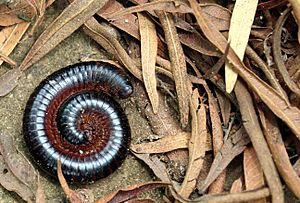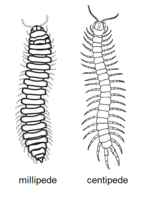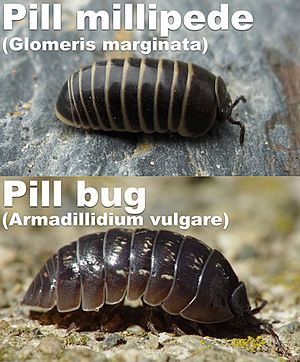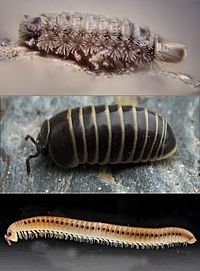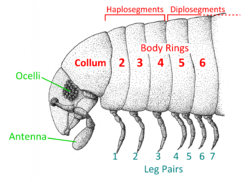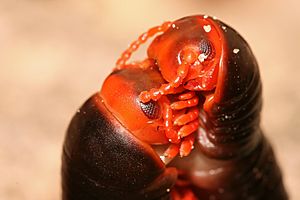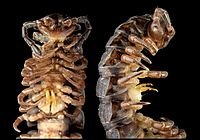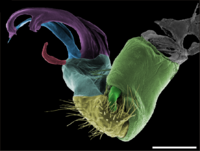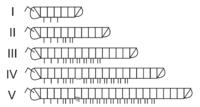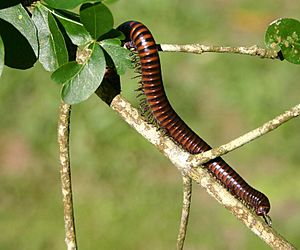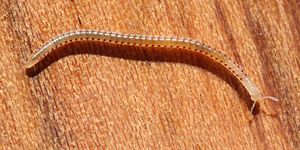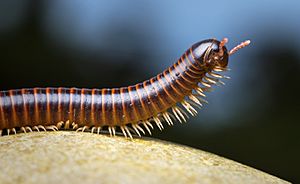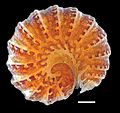Millipede facts for kids
Quick facts for kids Millipedes |
|
|---|---|
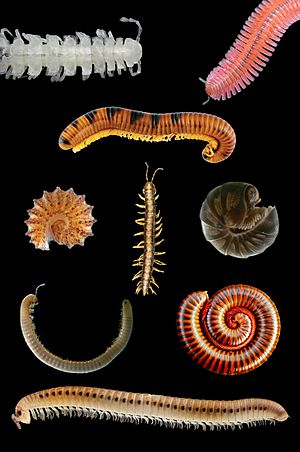 |
|
| An assortment of millipedes (not to scale) | |
| Scientific classification | |
| Kingdom: | |
| Phylum: | |
| Subphylum: | |
| Class: |
Diplopoda
de Blainville in Gervais, 1844
|
| Subclasses | |
|
Helminthomorpha |
|
Millipedes are a type of arthropod, which are animals with an outside skeleton. They are known for having many legs. Most millipedes have two pairs of legs on almost every body part. Scientists call them the class Diplopoda.
Most millipedes have long, round, or flat bodies. They can have more than 20 body parts, called segments. Some millipedes, like pill millipedes, are shorter. They can roll up into a tight ball when they feel scared.
There are about 12,000 known types of millipedes. They are grouped into 16 orders and about 140 families. This makes them the largest group of myriapods. Myriapods are a group that includes centipedes too.
Most millipedes eat dead leaves and other dead plants. Some eat fungi or drink plant juices. A very small number of millipedes hunt other small creatures.
Millipedes are usually not harmful to people. But sometimes, they can become pests in homes or gardens. They might damage young plants that are just starting to grow. Most millipedes protect themselves by releasing different chemicals. These chemicals come from small holes along their bodies. Tiny bristle millipedes are different. They are covered with soft, easily detached bristles.
Contents
- Millipede History: How They Evolved
- Millipedes vs. Centipedes: What's the Difference?
- Millipedes vs. Pill Bugs: Are They the Same?
- Millipede Characteristics: Body and Features
- Millipede Reproduction and Growth
- Millipede Habitat and Where They Live
- Millipedes and Humans: How We Interact
- Cool Facts About Millipedes
- Images for kids
- See also
Millipede History: How They Evolved
Millipedes were some of the first animals to live on land. This happened during the Silurian period, a very long time ago. Early millipedes probably ate mosses and simple plants.
Two main groups of ancient millipedes are now extinct. The Archipolypoda were "ancient, many-legged ones." They include the oldest known land animals. The Arthropleuridea group had the largest land invertebrates ever.
The oldest known land creature was Pneumodesmus newmani. It was a type of archipolypodan. This millipede was about 1 cm (0.4 in) long. It lived 428 million years ago. It had clear breathing holes, called spiracles. This shows it breathed air.
Arthropleura became the biggest land invertebrate. It grew to be at least 2 m (6 ft 7 in) long. Millipedes also show the first signs of chemical defense. They used chemicals to protect themselves.
Millipedes vs. Centipedes: What's the Difference?
Many people wonder about the differences between millipedes and centipedes. Both are myriapods and look similar. They both have long bodies with many segments and many legs. They also have one pair of antennae.
But they have many differences and grew apart over time. Their heads alone show how different they are. Millipedes have short, bent antennae for feeling around. They have strong jaws for chewing. They also have one pair of mouthparts fused into a lip.
Centipedes have long, thin antennae. They have small jaws and two pairs of mouthparts. They also have a pair of large, poisonous claws.
Millipedes vs. Pill Bugs: Are They the Same?
Some millipedes are called pill millipedes. This is because they look like certain woodlice. Woodlice are also known as pill bugs or "roly-polies."
However, millipedes and woodlice are not closely related. They just look similar because they live in similar places. This is a case of evolution where different animals develop similar traits.
Millipede Characteristics: Body and Features
Millipedes come in many shapes and sizes. They can be as small as 2 mm (1⁄16 in). Some can grow up to 35 cm (14 in) long. They can have as few as eleven segments or over three hundred.
Most millipedes are black or brown. But some species are brightly colored. These bright colors are a warning. They tell predators that the millipede is toxic.
Body styles are very different among the main millipede groups.
Millipede Head Features
A millipede's head is usually round on top and flat underneath. It has a pair of large jaws, called mandibles. The head also has one pair of antennae. These antennae have seven or eight parts. They have sensory cones at the very tip.
Millipede eyes are made of several simple eyes. These simple eyes are called ocelli. They are arranged in a group on each side of the head. Many millipede species used to have good eyesight. But over time, they lost their eyes and are now blind.
Millipede Body Structure
Millipede bodies can be flat or round like a tube. They are made of many similar parts, called segments. Each segment has a hard outer shell, called an exoskeleton.
The first segment behind the head has no legs. It is called a collum, which means neck. The next three segments each have one pair of legs. These are sometimes called the "thorax."
The rest of the segments, from the fifth one back, are special. They are called diplosegments, or double segments. Each diplosegment has two pairs of legs. Centipedes only have one pair of legs per segment. In some millipedes, the last few segments might not have legs.
The very last segment is called the telson. It has a legless ring before the anus. It also has two plates that close around the anus. There is a small scale below the anus.
Some millipedes have flat, wing-like extensions on their body sides. These are called paranota. They can be different shapes and sizes. Paranota help millipedes fit into tight spaces. They also protect the legs. And they can make it harder for predators to eat them.
Millipede legs have seven parts. They are attached to the underside of the body.

Millipede Internal Organs
Millipedes breathe through two pairs of small holes on each segment. These holes are called spiracles. They are located near the base of the legs. Each spiracle opens into a pouch. This pouch connects to a system of tubes called tracheae.
Their heart runs along the entire length of their body. A main blood vessel, called an aorta, goes into the head. Millipedes have two pairs of malpighian tubules. These organs help them get rid of waste. They are located near the middle of the gut. The digestive system is a simple tube. It has two pairs of salivary glands to help break down food.
Millipede Reproduction and Growth
In a group of millipedes called bristle millipedes, mating is indirect. Males leave sperm packets, called spermatophores, on special webs. Females then pick up these sperm packets.
In all other millipede groups, males have special legs. These are called gonopods. They use these gonopods to transfer sperm to the female.
Females lay between ten and three hundred eggs at a time. The number depends on the species. Many species lay their eggs on moist soil or dead plants. Some build nests lined with dried poop. They might even protect the eggs in silk cocoons.
Most species leave their eggs after laying them. But some millipedes, like those in the orders Platydesmida and Stemmiulida, care for their eggs and young.
Young millipedes hatch after a few weeks. They usually have only three pairs of legs. They also have up to four segments without legs. As they grow, they shed their skin many times. This process is called molting. Each time they molt, they add more segments and legs. They become adults when they reach their final molt. At this point, they can reproduce.
Millipede Habitat and Where They Live
Millipedes usually live on the forest floor. They prefer places with lots of moisture. You can find them in leaf litter, dead wood, or soil. Some species can even survive floods. They can live underwater for up to 11 months. A few types live near the seashore. They can handle slightly salty conditions.
Millipedes and Humans: How We Interact
Millipedes do not bite. They are mostly harmless to people. However, some tropical species release chemicals. These chemicals can cause skin irritation. This might include pain, itching, redness, swelling, or blisters. Sometimes, it can lead to cracked skin.
If these chemicals get into the eyes, they can cause irritation. This is called millipede burn. If this happens, flush the area with water right away. Further treatment helps relieve the effects.
Some millipedes are considered pests in homes. They can also damage crops. The spotted snake millipede is a known pest of sugar beets and other root vegetables. On the other hand, some of the larger millipedes are popular as pets.
Cool Facts About Millipedes
- The name "millipede" comes from Latin. It means "thousand feet."
- For a long time, no millipede was known to have 1,000 legs. But in 2021, a new record was set! The millipede Eumillipes persephone was found. Some of these millipedes have up to 1,306 legs. That's more than any other creature on Earth!
- About 12,000 millipede species have been named. But scientists think there could be as many as 15,000 to 80,000 species in total.
- Millipedes live on all continents except Antarctica.
- They can live from one to ten years. How long they live depends on the species.
- Millipedes can easily lose water from their bodies. So, most of them must live in moist or humid places.
- In 1963, a walking vehicle with 36 legs was designed. Its design was inspired by how millipedes move.
Images for kids
-
Approximate relative diversity of living millipede orders, ranging from about 3,500 species of Polydesmida to 2 species of Siphoniulida
-
Harpaphe haydeniana (Polydesmida)
-
Psammodesmus bryophorus camouflaged with moss growing on it
See also
 In Spanish: Milpiés para niños
In Spanish: Milpiés para niños


